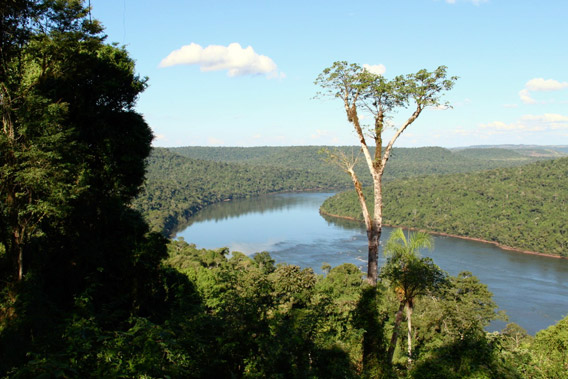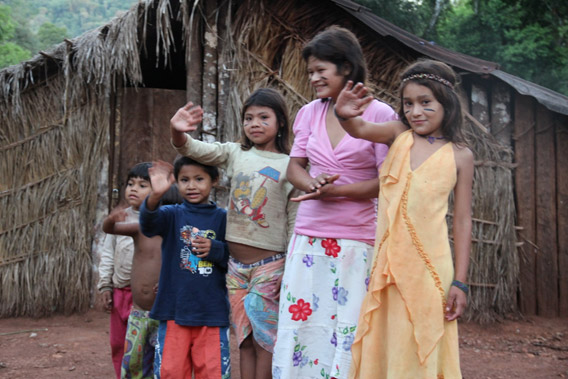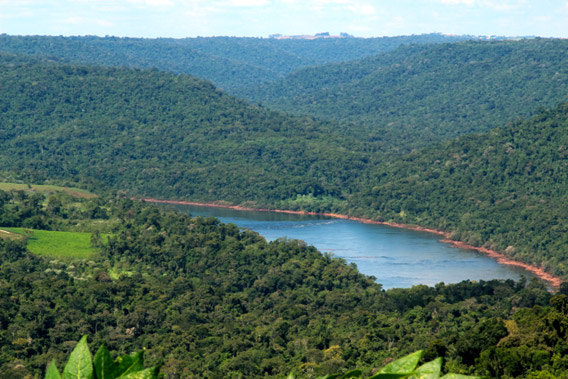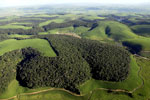
Young Guarani girl in Misiones. Photo by: World Land Trust.
Last month, three Guarani communities, the local Argentine government of Misiones, and the UK-based NGO World Land Trust forged an agreement to create a nature reserve connecting three protected areas in the fractured, and almost extinct, Atlantic Forest. Dubbed the Emerald Green Corridor, the reserve protects 3,764 hectares (9,301 acres) in Argentina; although relatively small, the land connects three protected other protected areas creating a combined conservation area (41,000 hectares) around the size of Barbados in the greater Yaboti Biosphere Reserve. In Argentina only 1 percent of the historical Atlantic Forest survives.
“The agreement that has been reached is truly ground-breaking,” John Burton the head of World Land Trust (WLT) said in a press release, “and it’s been heralded as such by the government of Misiones. In my view, it is probably the most important land purchase the WLT will ever make, because of the innovations involved and the wealth of biodiversity it protects.”
Once stretching along South America’s Atlantic coast from northern Brazil to Argentina, the Atlantic Forest (also known as the Mata Atlantica) has been fragmented by centuries of logging, agriculture, and urbanization. Around 8 percent of the Atlantic Forest still survives, most of it in Brazil, and most of it fragmented and degraded.
“The rainforest of Misiones is the largest remaining fragment of the Atlantic Rainforest of South America. It is full of unique plants and important animal species—it is vital to preserve the best sample of this ecosystem,” noted Sir Ghillean Prance, an advisor to the project and scientific director of the Eden Project, in a press release.
The establishment of the Emerald Green Corridor, which was purchased from logging company Moconá Forestal, ends 16 years of the Guarani communities fighting for their traditional lands. The land will now be considered Traditional Indigenous Lands, while the indigenous community is currently working on a conservation management plan to protect the forest and its species.
The provincial government of Misiones plans to highlight the project at the Rio+20 UN Summit on Sustainable Development as an example of conservation and indigenous rights.
The corridor will connect Moconá Provincial Park in Argentina with Esmeralda Provincial Park and the Turvo State Park in neighboring Brazil. The region is home to a stunning variety of imperiled species including the jaguar (Panthera onca), listed as Near Threatened by the IUCN Red List; the giant river otter (Pteronura brasiliensis), Endangered; the giant anteater (Myrmecophaga tridactyla), Vulnerable; the maned wolf (Chrysocyon brachyurus), Near Threatened; the oncilla (Leopardus tigrinus), Vulnerable; the Brazilian merganser (Mergus octosetaceus), Critically Endangered; the black-fronted piping guan (Pipile jacutinga), Endangered; bare-throated Bellbird (Procnias nudicollis), Vulnerable; the saffron toucanet (Pteroglossus bailloni); and the harpy eagle (Harpia harpyja), Near Threatened.
The WlT has received initial management support for the Emerald Green Corridor from the Blake Family Trust, Eurojersey, Calypso Soft Drinks, PricewaterhouseCoopers, Conoisseur Dry Cleaners and Treadz.

The Atlantic Forest in Misiones. Photo by: WLT.

Guarani family welcomes John Burton (WLT CEO) to their village the day after he signs the agreement, they later sing a traditional song in thanks. Photo by: WLT.

Overlooking the Atlantic Rainforest and Uruguay River in Misiones, then onwards to neighboring Brazil. Photo by: WLT.
Related articles
Expanding ethanol threatens last remnants of Atlantic Forest

(09/26/2011) Aggressively expanding sugarcane ethanol is putting Brazil’s nearly-vanished Atlantic Forest at risk, according to an opinion piece in mongabay.com’s open-access journal Tropical Conservation Science. Already down to less than 12 percent of its original extent, the Atlantic Forest—home to over 7,000 species that survive no-where else—is facing a new peril from ethanol, used as an alternative to gasoline and often touted as ‘green’ or ‘environmentally-sustainable’.
Atlantic Forest stores less carbon due to drastic fragmentation
(09/26/2011) The Atlantic Forest in Brazil is one of the most fragmented and damaged forests in the world. Currently around 12 percent of the forest survives, with much of it in small fragments, many less than 100 hectares. A new study in mongabay.com’s open-access journal Tropical Conservation Science finds that the bloodied nature of the Atlantic Forest impacts its capacity to sequester carbon. The study found that 92 percent of the forest stored only half its potential carbon due to fragmentation and edge-effects, which includes damage due to winds and exposure to drought.
Destruction of Brazil’s most endangered forest, the Mata Atlantica, slows

(05/27/2011) Deforestation of Brazil’s most threatened forest ecosystem dropped substantially during the 2008-2010 period according to new data released by Brazil’s National Institute for Space Research (INPE) and Fundação SOS Mata Atlântica. Analysis of satellite images across 16 of the 17 states the Atlantic Forest spans found that 312 square kilometers of forest was cleared between 2008 and 2010, down from 1,029 square kilometers between 2005 and 2008. Deforestation was concentrated in the states of Minas Gerais, Bahia, Santa Catarina and Parana.
From Cambodia to California: the world’s top 10 most threatened forests

(02/02/2011) Growing populations, expanding agriculture, commodities such as palm oil and paper, logging, urban sprawl, mining, and other human impacts have pushed many of the world’s great forests to the brink. Yet scientists, environmentalists, and even some policymakers increasingly warn that forests are worth more standing than felled. They argue that by safeguarding vulnerable biodiversity, sequestering carbon, controlling erosion, and providing fresh water, forests provide services to humanity, not to mention the unquantifiable importance of having wild places in an increasingly human-modified world. Still, the decline of the world’s forests continues: the FAO estimating that around 10 million hectares of tropical forest are lost every year. Of course, some of these forests are more imperiled than others, and a new analysis by Conservation International (CI) has catalogued the world’s 10 most threatened forests.
2,700 sq km of Brazil’s most endangered rainforest destroyed in 8 years
(12/03/2010) 270,000 hectares of the Mata Atlântica, Brazil’s most threatened ecosystem, was cleared between 2002 and 2008, reports a new assessment by the Brazilian Institute of Environment and Natural Resources (IBAMA). Less than 8 percent of the Atlantic forest—famed for its biodiversity—remains.
U.S. signs debt-for-nature swap with Brazil to protect forests
(08/13/2010) The United States will cut Brazil’s debt payments by $21 million under a debt-for-nature that will protect the Latin American country’s endangered Atlantic Rainforest (Mata Atlantica), Caatinga and Cerrado ecosystems.














